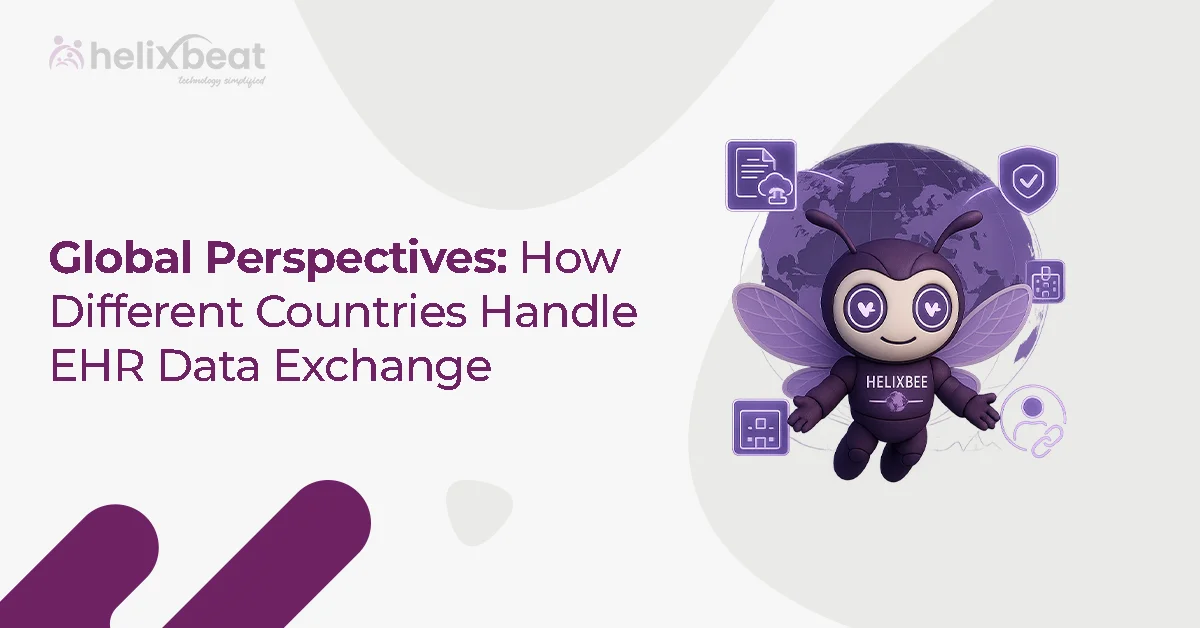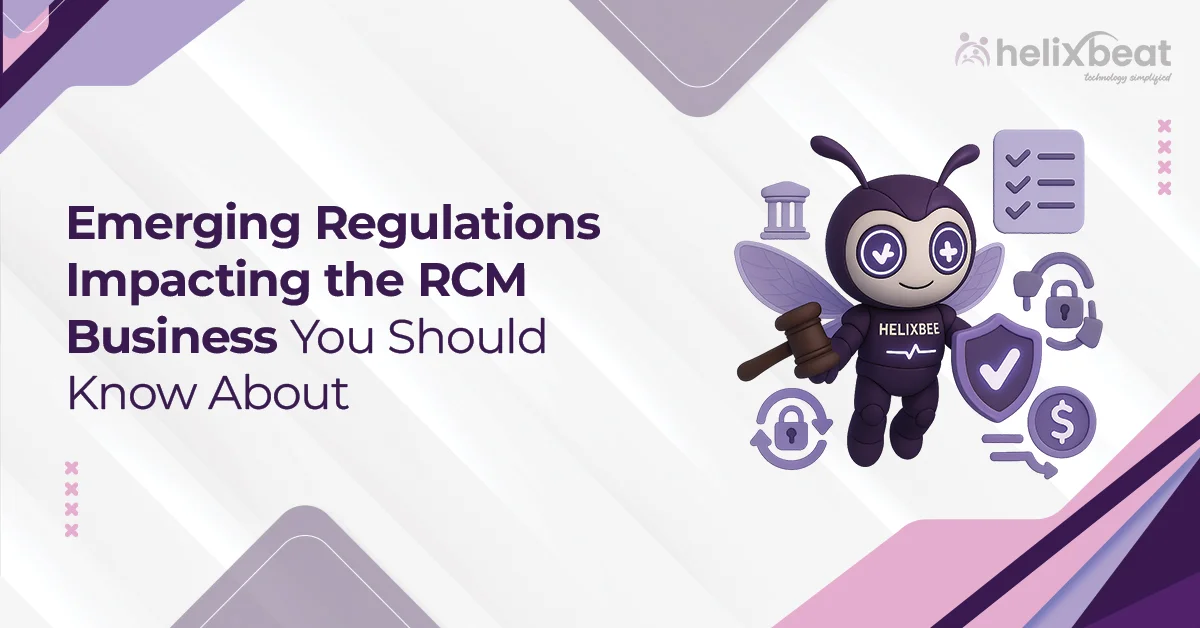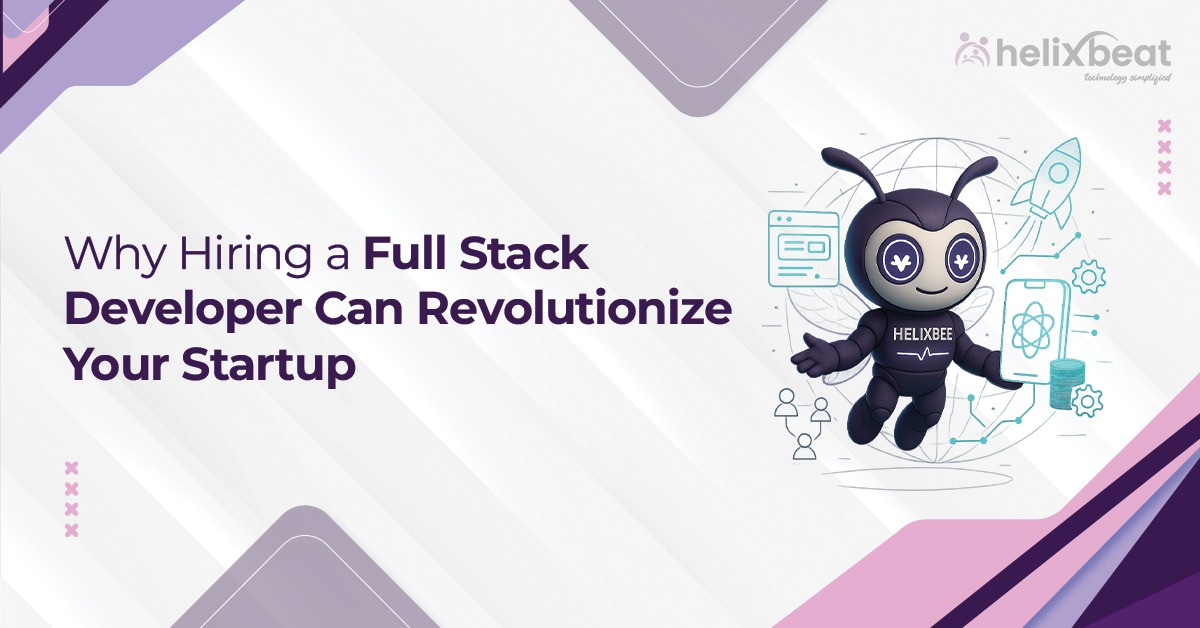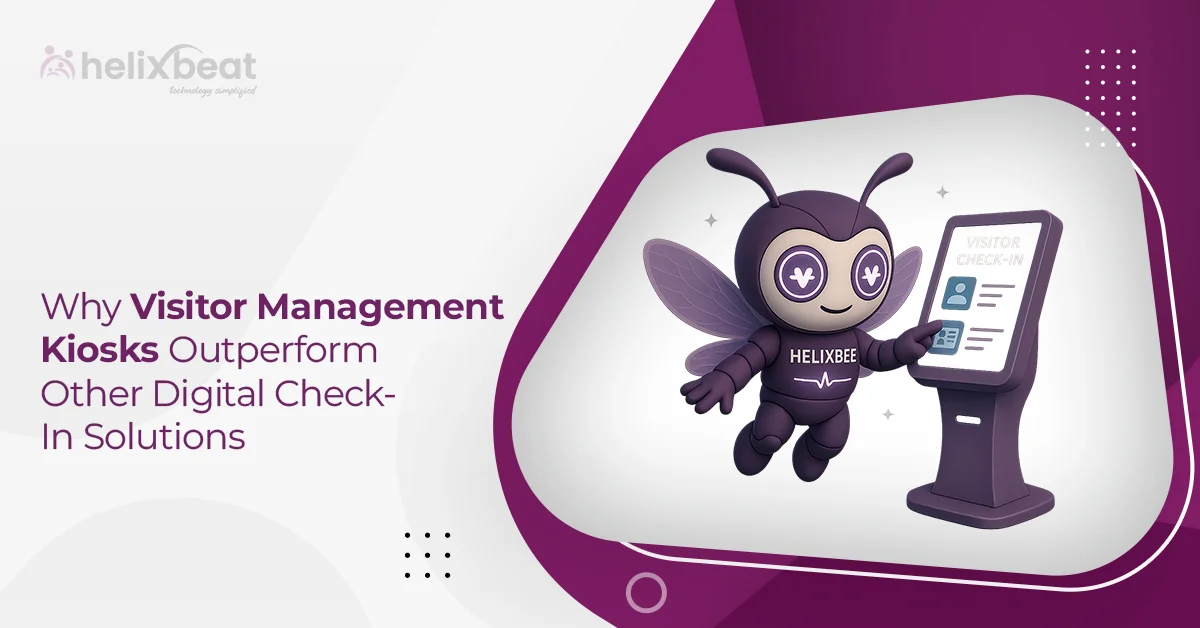“Is your healthcare app truly connected or just pieced together?” API integration is crucial for developing secure, seamless, and scalable digital health solutions. Whether it’s pulling patient vitals from a wearable device, syncing EHR records, or submitting insurance claims in real time, API integration determines how effectively data flows within your ecosystem.
Enter GENIUS by Helixbeat, a portal that provides plug-and-play access to APIs, including PULSE, AERIS, and FUSION. Read the blog further to discover how to choose the right API for Healthcare app and how Helixbeat’s GENIUS can accelerate your integration journey.
Table of Contents
What is API Integration in Healthcare?
How can healthcare systems talk to each other without missing a beat? API Integration in healthcare is the process that enables different software systems, such as Electronic Health Records (EHRs), billing platforms, and telemedicine apps, to communicate and exchange data smoothly and securely.
API integration is essential, as it enables healthcare providers to access real-time data, ensuring patient information remains accurate and current. This connectivity enhances interoperability, aiming for a coordinated and efficient healthcare system.
Common API Integration Services in Healthcare Include:
- EHR API Integration for syncing clinical data.
- Patient engagement platforms are integrating with mobile apps.
- Telehealth services connect remotely with providers.
- Billing and claims processing systems ensure faster reimbursements.
REST vs. SOAP vs. FHIR: The Basics
Understanding the fundamentals of API integration is crucial when determining between REST, SOAP, and FHIR, each of which is designed for different needs in healthcare data exchange. Choosing the proper API integration method depends on your app’s requirements for security, speed, and interoperability.
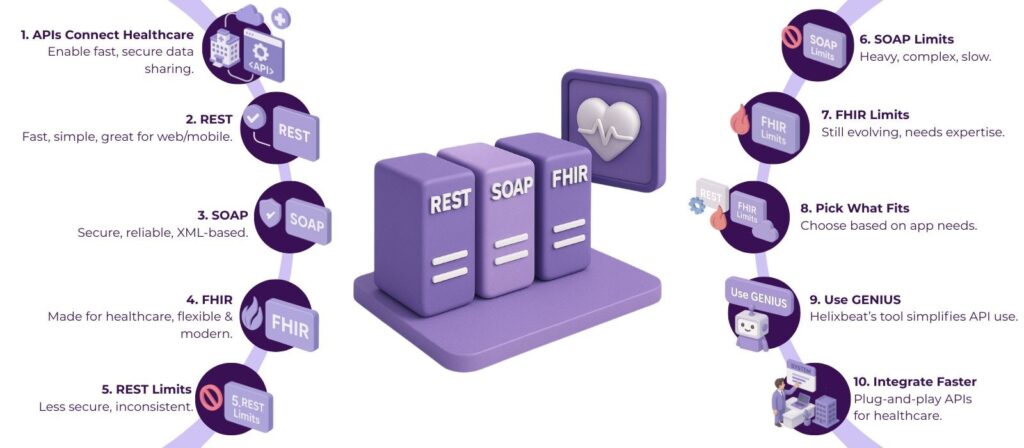
What is REST?
REST (Representational State Transfer) is an architectural style widely adopted for modern API integration in healthcare apps. It uses HTTP methods to perform functions on resources, making it ideal for lightweight, scalable data exchange. Features of REST :
Stateless Communication
- REST APIs are stateless, so each client request must include all the information the server needs to process it.
- There is no reliance on stored context between requests, which simplifies server design and improves scalability.
- This statelessness ensures that REST APIs can handle a high volume of independent requests efficiently, a feature that is particularly significant for healthcare apps, where quick and reliable data transfer is essential.
Use of Standard HTTP Methods
RESTful APIs utilize HTTPs to carry out performant resource operations, including:
- GET to retrieve data,
- POST to create new resources,
- PUT to update existing resources,
- DELETE to remove resources, and
- PATCH for partial updates.
This use of widely understood HTTP verbs makes REST intuitive to develop and consume, reducing development time and easing integration across different platforms.
Multiple Data Formats
- While REST supports multiple data formats, JSON (JavaScript Object Notation) is the most popular due to its lightweight structure and ease of use in web and mobile applications.
- REST can also handle XML and plain text when necessary, offering flexibility to work with diverse systems and data requirements, including legacy healthcare platforms that may still rely on XML.
Resource-Oriented Architecture
- REST APIs focus on resources, such as patients, appointments, or lab results, each identified by a unique Uniform Resource Locator.
- Instead of focusing on actions or methods, REST models the data itself as resources that clients can interact with, which aligns naturally with healthcare data structures and simplifies API design and use.
Scalable and Flexible
- REST APIs are created to enable distributed systems, which allows them to be very scalable and robust.
- Their stateless nature means servers can handle many requests without session management overhead.
- Additionally, REST supports caching, which improves performance by reducing the need for repeated requests for the same resource.
- This scalability and flexibility are crucial for healthcare applications that must serve multiple users simultaneously while delivering fast and reliable responses.
Challenges of REST
Understanding the challenges of REST in healthcare API integration helps you prepare better solutions. Key challenges include:
Lack of Strict Standards
- REST is an architectural style, not a strict protocol.
- This leads to inconsistent implementations across different systems.
Security Relies on Transport Layer
- Security depends mainly on HTTPS and OAuth.
- Unlike SOAP, REST lacks built-in security protocols, such as WS-Security.
Limited Transaction Support
- REST’s statelessness complicates complex multi-step workflows.
- E.g., insurance claims, medication orders.
API Versioning Challenges
- Maintaining backwards compatibility requires diligent version management.
- The lack of formal contract mechanisms, in contrast to SOAP’s WSDL, raises the likelihood of encountering breaking changes.
- The absence of formal contract mechanisms, unlike SOAP’s WSDL, increases the risk of breaking changes.
What Is SOAP?
SOAP (Simple Object Access Protocol) is a protocol used for exchanging structured information in web services based on XML. It defines a standardized messaging framework that enables communication between applications over the internet, often in complex or enterprise environments.
Features of SOAP
SOAP (Simple Object Access Protocol) is a robust protocol widely used in healthcare API integration for its strict standards and security features. Its key features include:
Protocol-Based
- SOAP follows strict rules for message formatting and communication.
- It makes it suitable for settings where precision is essential.
- Its design supports complex healthcare workflows that demand reliability and consistency.
XML Messaging
- SOAP exclusively uses XML for both requests and responses.
- This structured format ensures that messages are highly detailed and standardized, providing a clear and consistent approach.
- It is essential when exchanging sensitive healthcare data between systems.
Built-in Securit
- One of SOAP’s key strengths is its support for WS-Security standards.
- This includes encryption, authentication, and message integrity features that protect patient information during transmission — a crucial requirement in healthcare.
Extensibility
- SOAP is versatile and can operate over various transport protocols, such as HTTP, SMTP, and TCP, allowing it to integrate seamlessly into diverse IT infrastructures found in healthcare organizations.
Stateful or Stateles
- Unlike REST, SOAP can maintain stateful operations, which is valuable in transaction-heavy healthcare applications, such as billing or claims processing, where multiple steps must be tracked and maintained.
Formal Contracts
- SOAP uses WSDL (Web Services Description Language) to define service contracts.
- This formal specification outlines exactly how services should be called and what data to expect, reducing ambiguity during integrations.
Discover How Helixbeat’s FUSION Simplifies Secure SOAP Integrations — Request a Demo
Challenges of SOAP
Complexity
- The reliance on XML and strict protocol standards makes SOAP implementations heavier and more complex compared to modern alternatives.
- Developers often face challenges managing verbose messages and adhering to rigid formats.
Performance Overhead
- SOAP messages tend to be larger due to XML’s verbosity, which can slow down communication.
- Especially in bandwidth-constrained environments such as mobile health apps.
Limited Flexibility
- SOAP’s rigidity makes it less adaptable for lightweight applications or systems that require rapid, iterative development cycles.
- This can slow innovation in patient-facing apps.
Steep Learning Curve
- Due to its complexity, developing, debugging, and maintaining SOAP services require specialized knowledge and tools.
- Thereby increasing the time and cost for healthcare providers.
What Is FHIR?
FHIR (Fast Healthcare Interoperability Resources) is a healthcare-specific standard developed by HL7 for exchanging electronic health information. It builds upon REST principles and defines modular “resources” to represent clinical and administrative data.
Features of FHIR
Built on RESTful Architecture
- FHIR uses standard HTTP methods (GET, POST, PUT, DELETE) and URLs to interact with healthcare resources.
- This approach enables developers to seamlessly integrate data access into modern applications, leveraging the scalability and simplicity of REST.
Modular Resources
- FHIR breaks down healthcare data into well-defined resources such as Patient, Observation, Medication, Appointment, and more.
- This modular design simplifies data exchange by allowing apps to retrieve or update only the necessary pieces of information, improving efficiency.
Supports JSON and XML
- To accommodate different systems and preferences, FHIR supports both JSON and XML formats.
- JSON’s lightweight nature is especially favored in mobile and web apps, enhancing performance without sacrificing interoperability.
Extensible Design
- While maintaining strict core definitions, FHIR allows custom extensions to address unique clinical workflows or organizational needs.
- This flexibility ensures interoperability without losing the ability to tailor solutions.
Optimized for Mobile and Cloud
- FHIR’s REST-based approach and lightweight data formats make it ideal for cloud-native healthcare platforms and mobile applications.
- Enabling real-time data access and remote patient monitoring.
Robust Security
- FHIR integrates with modern security protocols, such as OAuth 2.0 and SMART on FHIR.
- Ensuring secure and authorized data access that complies with healthcare regulations, including the Health Insurance Portability and Accountability Act (HIPAA).
Read this article of FUSION for Advanced FHIR API Integration
Challenges of FHIR
Implementation Complexity
- Deploying FHIR requires solid expertise in both RESTful API design and healthcare data standards.
- Healthcare organizations and developers must invest in understanding clinical contexts and FHIR resources to implement them effectively.
Partial Adoption
- Although FHIR adoption is skyrocketing, not all healthcare systems have fully embraced the standard yet.
- This can create integration gaps, especially when connecting legacy EHR systems with modern apps.
Versioning and Compatibility Issues
- Multiple FHIR versions exist (e.g., DSTU2, STU3, R4), and variations between them may cause compatibility challenges during integration or when exchanging data across different organizations.
Resource Overhead
- Complex healthcare datasets and large volumes of resource instances may strain system performance.
- Efficient data management and querying strategies are crucial for maintaining responsiveness.
How GENIUS Helps Simplify API Integration?
What if integrating complex healthcare APIs could be as easy as clicking a button? For healthcare developers and organizations, API integration often feels like guiding a maze of standards, security concerns, and limitations of legacy systems.
Helixbeat’s GENIUS platform streamlines this challenge by offering a comprehensive suite of APIs precisely created for healthcare. The best part is that GENIUS APIs are plug-and-play, meaning you don’t need to create something from scratch — simply integrate the APIs into your system for a seamless solution.
The Bottom Line
API integration is crucial for seamless data flow and enhanced patient experiences in healthcare. Choosing the proper API standard—like REST, SOAP, or FHIR—is crucial, and Helixbeat’s GENIUS can simplify the process. With its no-code gateway and pre-built connectors, GENIUS enables you to focus on delivering quality care instead of addressing technology challenges.
As the healthcare industry moves toward greater interoperability and real-time data exchange, leveraging a trusted API integration platform is no longer optional; it is essential. Helixbeat’s GENIUS equips you with the tools and expertise to confidently navigate evolving standards and legacy systems. Ready to transform your healthcare app development and integration journey?
Start your free trial and accelerate your healthcare app development with Helixbeat GENIUS.
Suggested Reads
FAQs
- What is the difference between SOAP and REST?
SOAP is a strict protocol relying on XML, designed for high security and transaction compliance. REST is an architectural style that’s flexible and uses multiple data formats, making it ideal for modern web and mobile apps.
- How do SOAP APIs and REST APIs work?
SOAP APIs send structured XML messages wrapped in a SOAP envelope, requiring strict rules. REST APIs interact with resources using HTTP methods, often exchanging lightweight JSON data.
- Which is safer, SOAP or REST?
SOAP has built-in security standards like WS-Security, making it traditionally stronger for sensitive transactions. REST secures data via HTTPS and OAuth, suitable for most modern applications, especially with proper implementation.
- Which is better, SOAP or REST API?
REST is generally preferred for its simplicity, speed, and flexibility, while SOAP is better suited for applications requiring strict security and formal contracts.
- How can I check if my system supports FHIR?
Review your system’s documentation or consult your vendor to confirm if it supports HL7 FHIR standards and APIs for healthcare data exchange.
- Which API standard should I use for HIPAA compliance?
Both SOAP and REST can be HIPAA compliant if implemented with proper security measures, but FHIR-based REST APIs are increasingly popular in healthcare.
- What are the similarities between SOAP and REST?
Both protocols for API communication support XML data formats (though REST supports others) and facilitate system interoperability.
- Is REST scalable for enterprise healthcare use?
Yes, REST APIs are highly scalable and widely adopted in enterprise healthcare environments for their performance and ease of integration.






